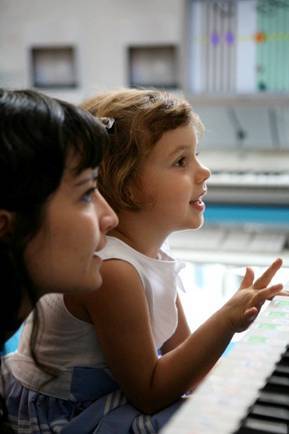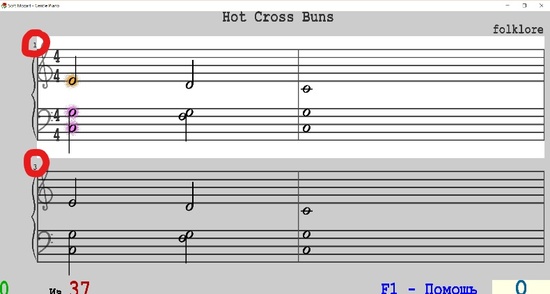Preparatory B (from 3 to 5). Lesson 1

Welcome to our Academy!
You FREE Demo version is here
You full version access is here
 Link to buy piano stickers is here
Link to buy piano stickers is here
Soft Learning for The Helicopter Parent
However there was no way she could put them together, to make the word "mama!"
I battled with her. It felt like I was up against a brick wall. Battle, I would like you to notice is the key word here, it defines uncaring, harsh, unnatural teaching.
My daughter was continually 'disappointing' me.
Deep inside I could not come to terms with this. I was frustrated. Why couldn't she understand such simple things? So I started thinking about her genes. I agonized, trying to understand, who in our family was that slow. I had already quarreled with the grandparents and my bitterness about the twists of fate went so deep, that I felt that I was a terribly unhappy person next to this, 'dummy,' I had brought into this world.
In front of me sat a little girl, my very own daughter, who could not understand how to combine two letters to make on syllable. I also saw a monster, who was doing it on purpose so as to sap all my energy and to get to me. If the truth be told, the monster in this situation was me.
When battling with someone you are imposing your opinion about them, on them. To determine whether you are battling with someone or not, is quite simple. It is a particular physical state and the muscles responsible for it are those around the neck and shoulders where your shirt collar goes.
That is where you feel the tension. If you realize this at the right time, you can learn to snap out of it.
This is the position of bird of prey. You don't sit, but you 'hover' over the student or child. You don't take your eyes off him, you are waiting for his reaction. You behave as if the child owes you something and you attempt to regulate his every move. You think you are in control of the situation, but you are in actual fact, invading his/her personal space.
The shadow of your 'wings' deprives her of the sun and the opportunity to grow by herself and get stronger.
You ask questions, but you don't get any answers to them. You endeavor to implant the answers, by the power of thought(make no mistake, tensing your muscles has nothing to do with the transferring of ideas from a distance!)
You can stare at the person, raise or lower your voice, use short phrases or extended sentences. All this will bring no results. And the harder you battle, the more effort you put forth, the quicker you lose your strength and become exhausted.
And all along you are thinking that you are putting your energy into the other person and he is absorbing your strength. That's just an illusion! You pour out your heart, like a soldier pours our his blood in a battle. You are fighting against windmills. This is a futile struggle. This is one of the examples of non-soft teaching. It is harsh. It is in vain. It cripples children.
Soft teaching excludes any encroachment into the student's space. Only when the student himself, invites you into his own personal space, is he ready to ask questions and listen to the answers and then it is time to share your knowledge with him. You sit near the child, lean back on the chair nonchalantly and observe, how he is teaching himself. You watch this calmly. So you don't push the child, he is pushing you. It is he, who is, every now and then disturbing your daydream, and from time to time asking you questions. That is the time to answer them. What is more you could start your answer with the phrase: Oops, why didn't I think of that. Good idea!
BUT HOW CAN THIS BE ACHIEVED?– you may well ask.......
The first thing you have to learn–is to observe and listen.The second, is to be able to ascertain and build on what the child already knows, is able to do and is already doing.
That's the way to go. Not only what they know, but also what they are able to do and enjoy doing well.
So, after observing my daughter for a while, it was easy for me to understand, what her strong points were and what she loves about reading more than anything else.
She knew all the letters and could tell me what they were, without making any mistakes.
She loved doing that. Did she simply adore it when I read her a story?
Yes, she loved listening to stories.
So, the only thing she didn't like and couldn't do was listening and watching at the same time. What I'm saying is, she couldn't understand the mechanical process, when letters become syllables, words, sentences and stories. Can you explain the mechanics of reading words? It's a waste of time.
I suggested to my daughter, that we read a book–together. We sat next to each other, I started to read slowly and with intonation, her favorite story, putting my finger under each letter as I read, and I asked her to follow along.
She began to see how the process of creating syllables, words and sentences worked. The only thing I asked her to do was to watch how I combined the letters into syllables and words. It wasn't difficult for me: I read her books often. She enjoyed it, as she was listening to her favorite story. It was after only a couple of nights of reading this way, when my daughter said to me: Lets read it together?
Remember what you should say at this point? Oops, why didn't I think of that? Good idea! And that was what exactly I said to her.
It was then that my daughter started controlling the process herself: 'I know that word and will read it myself!' Oops, why didn't I think of that. Good idea! Things started to happen. It was an irreversible development.
My daughter came to love reading and that is what we need to happen. During our lives, we are often required to become teachers, formally and informally. When explaining something new to someone, it is good to remember about soft teaching. In gymnastics this approach is straightforward. If it is difficult for you to impart your knowledge to someone else and you are feeling tension in the area of your eagle's 'wings:'
-
Take a deep breath!
-
Relax the muscles in your neck and change your mindset from one of a predator to that of a detached bystander.
-
Be sure to have something to lean back on.
-
After chilling out, remember to look at the situation as an observer.
...
![]() Today let's find out the names of musical notes in our Academy :
Today let's find out the names of musical notes in our Academy :
![]() Find Level 1 Cards in your package or buy by following this link. Cut out the first pages with pictures of musical notes.
Find Level 1 Cards in your package or buy by following this link. Cut out the first pages with pictures of musical notes.

![]() Listen to the 1st section of the Note Alphabet Song - Chant. Check out the order of music notes from Do to Do:
Listen to the 1st section of the Note Alphabet Song - Chant. Check out the order of music notes from Do to Do:
First steps of the Theory interaction![]() Ask your child to pick a card (Flash cards Level 1 pages 1-2 with only pictures of notes) from the pile of them as Door, Rain, and Mirror etc.
Ask your child to pick a card (Flash cards Level 1 pages 1-2 with only pictures of notes) from the pile of them as Door, Rain, and Mirror etc.![]() First steps in interactive music theory: Ask your child to choose a card and say its name:
First steps in interactive music theory: Ask your child to choose a card and say its name:
Assemble the row of from Do to Do in forward and backward movement.
....
Today we start working with the module  Gentle Piano®
Gentle Piano®
1. Follow this link in order to download the unique LMZ file of this piece. Save the file in a folder that you can easily find
2. Now go to your existing folder "Songs" To do this, you need to find disk C -> Program Files (X86) -> Soft Mozart -> Songs in Windows,
and in Mac open this folder in the Soft Mozart folder (My Apps )
3. Right-click your computer mouse and create a new folder. Give it a name, for example 0, so that the folder is always at the top of the library. You can add songs for your child to it.
4. Copy - paste the previously saved LMZ file to the "0" folder.
5. Open Gentle Piano program and find the Album 0 and your piece 'Butterfly DO'
Now your child needs to learn to press the key long enough before the butterfly appears!

If the key is not pressed long enough, you will see Mr. Oops.

If you press the wrong key, a little spider will appear:

Share your experience with us in your progress diary!
Secondly, let's start learning a piano piece popular with all beginners:
Introductory Songs (Level 0) -'Hot Cross Buns' - "Hot Easter Buns".
Press S to listen to the song Now let's learn how to cut shorter pieces of a piece.
For example, let's reduce a piece to four measures. Press 6 on your computer keyboard and you will see the column numbers on the left: 
Use the down arrow to go to number 5 and press CTRL + Backspace to keep measure 4 intact.

- Press R (right hand) 1 - first vertical presentation. - Have your child play 4 measures with his right hand.
Let us know how it went Start a learning diary and take notes!
We do not and will not have "saving results" on a computer, do not print on them!
Take notes in your notebook. It is necessary to look away from the screen and it is more useful for the eyes.
If you want to save the results online, enter them into your diary in our forum in a special section for this - your progress diary!
If the child has easily coped with 4 measures of the piece, you can invite him to play the whole piece with his right hand.
Video example
The best way to record is as follows:
Gentle Piano: Date, Song Title, Album * optional *
First play - number of correct notes (bottom left of the screen) / time delay (bottom right of the screen)
Second play - repeat the same.
Compare the numbers!
If more correct notes appear in less time, your child is progressing!
1. ____/____ 2_____/______
Did your child manage to play these few notes or would he rather see the spiders and Mr. Oops?
Let us know.
....
![]() ТEASER: Joseph Haydn "Surprise Symphony" # 94
ТEASER: Joseph Haydn "Surprise Symphony" # 94  Gentle Piano®: Favorite Classics Primer Joseph Hayden "Surprise Symphony"
Gentle Piano®: Favorite Classics Primer Joseph Hayden "Surprise Symphony"
Try to play the theme from the symphony with your right, left and two hands (R, L and P)
Let your child try to find a pair of notes in the right or left hand too. But don't force!
An example of orchestral performance can be found on YouTube Symphony # 94
 .
.
Visit our Soft Mozart forum and start your progress diary here. Use the current year section. This is the place for you to ask questions and share your experiences.
At least 2 photos and 1-2 videos of the listed activities will count towards your child's credits for the graduation DIPLOMA. Please upload the video to You Tube, copy the address from the BROWSER window and paste it into your Progress Diary. Do not forget to indicate the year and type of work in the description of your Soft Mozart Academy photo / video.
Sincerely Yours,
Hellene Hiner

Video success:
PS
 Would you like to receive lessons by email weekly? Subscribe to the e-mail lesson here:
Would you like to receive lessons by email weekly? Subscribe to the e-mail lesson here:
All the lesson plans:
For 2+ students
For students from 3 to 5
For students 5+
Always check here, if we have any recital! You and your child will benefit a lot from participating in our concerts!
Your place to start your progress diary is here.



